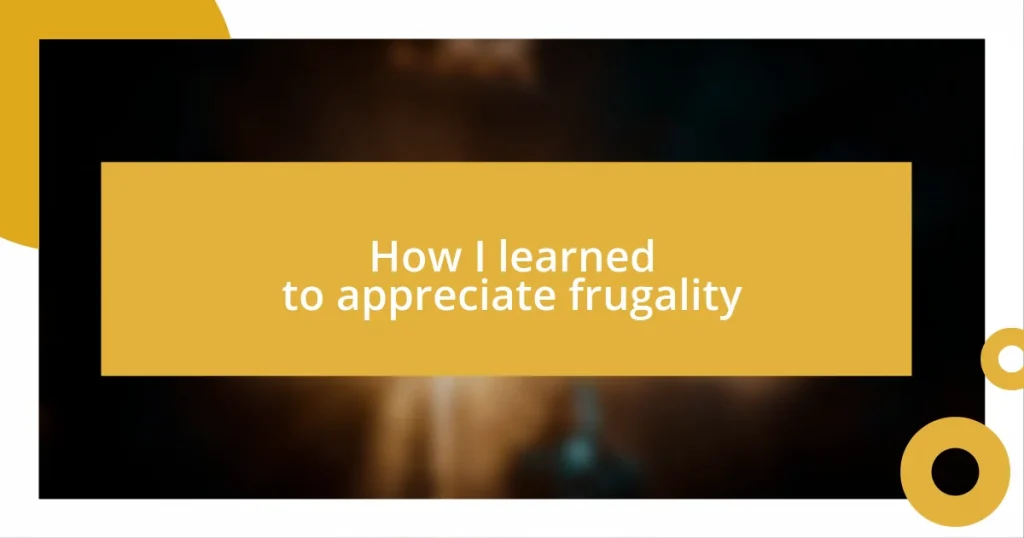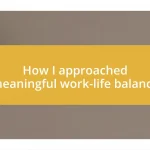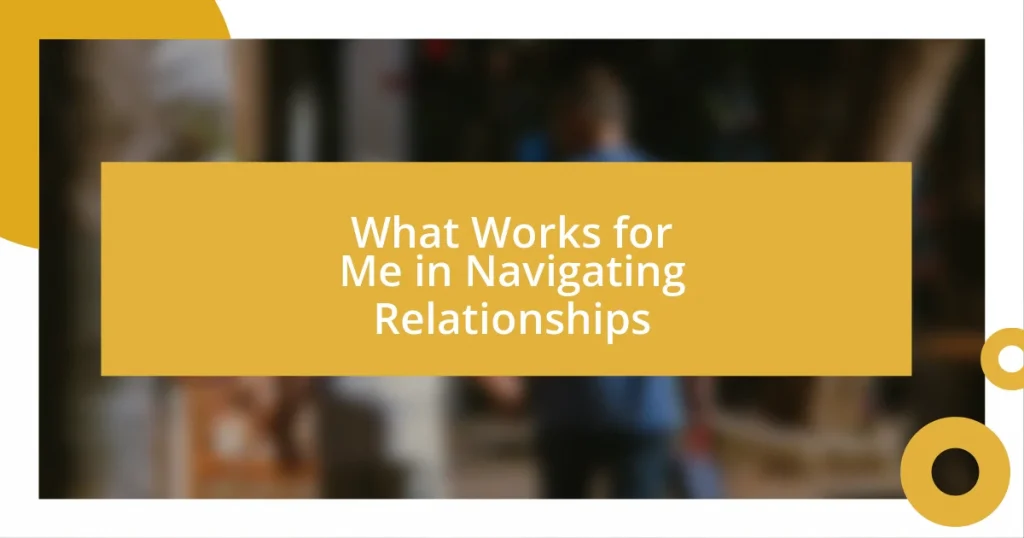Key takeaways:
- Frugality is a mindset focused on sustainability and resourcefulness, emphasizing experiences over possessions.
- Key experiences such as gardening and DIY projects foster creativity, financial security, and stronger relationships.
- Practicing patience in spending decisions and regularly reflecting on personal values enhances overall satisfaction and supports long-term frugality.

Understanding the concept of frugality
Frugality is often misunderstood as mere penny-pinching, but it runs much deeper. For me, it began during a particularly tight month when I had to stretch every dollar. I remember the thrill of finding a cozy café that sold delicious coffee for half the price of my usual spot; it made me realize that being frugal doesn’t mean sacrificing quality or enjoyment.
When I think about frugality, I see it not just as a way to save money, but as a mindset that values resourcefulness and sustainability. I found myself questioning: What truly brings joy to my life? I started focusing on experiences instead of possessions. It was eye-opening to discover that an evening spent cooking with friends was far more fulfilling than the latest gadget I was tempted to buy.
Through my journey, I’ve learned that frugality fosters creativity. I remember hosting a potluck dinner where everyone brought a dish. Not only was it budget-friendly, but we shared laughter and stories that filled the room with warmth. It made me wonder: What rich memories can we create when we spend wisely and invest in each other instead of in stuff?

My journey toward frugality
My move toward frugality started unexpectedly, during a weekend adventure that spiraled into a budget nightmare. While visiting a local market, I overspent on artisanal products that quickly lost their charm. Reflecting on that experience, I realized that true enjoyment often doesn’t stem from spending, but from the stories and memories we create. This revelation nudged me to embrace a simpler lifestyle, focusing on local experiences rather than extravagant purchases.
One of my biggest turning points came when I decided to try my hand at gardening. I had this patch of soil that sat unused in my backyard, and I thought, why not turn it into something productive? Watching vegetables grow from mere seeds brought immense joy, and not just because of the savings! It became a fulfilling project, teaching me patience and persistence. The fruits of my labor—literally!—filled my heart with pride and my kitchen with fresh produce.
I also discovered the joy of DIY projects. I remember transforming an old table into a stylish centerpiece with just some sandpaper and paint. This experience not only saved me money but also gave me a sense of accomplishment. Knowing that I could create something beautiful from what I already had shifted my perspective on spending. Now, I often ask myself how I can valorize my current resources before considering a new purchase.
| Lesson Learned | Personal Experience |
|---|---|
| Living within a budget leads to creativity | Turning an old table into a new centerpiece |
| The value of experiences over possessions | Gardening became a rewarding hobby |
| Emphasizing resourcefulness | Finding a café with affordable coffee |

Recognizing the benefits of frugality
Recognizing the benefits of frugality has truly reshaped my outlook on life. I still recall the day I completely transformed my perspective during a simple grocery run. I went in with a list, ready to grasp every sale. Instead, I realized I was enjoying the time spent browsing local produce, connecting with vendors, and discovering new recipes to try at home with what I already had. That moment brought an unexpected joy—suddenly, saving money felt less about deprivation and more about abundance.
Here are some benefits of embracing frugality:
-
Enhanced Creativity: I’ve found joy in reinventing old items rather than purchasing new. For instance, I made invitations for a friend’s birthday party using leftover scraps of paper—a delightful way to express my creativity while saving money.
-
Sustainable Living: Practicing frugality fosters eco-friendly habits. I’ve started sewing my own reusable bags, which not only cut costs but also reduce waste.
-
Financial Security: I noticed that the more I spent wisely, the more my savings grew, leading to a sense of security that was liberating. I can’t describe the relief I felt when an unexpected expense arose, yet my budget allowed for it without stress.
-
Stronger Relationships: By prioritizing experiences over material goods—like hosting a game night with friends instead of dining out—I deepened my connections and created valuable memories while keeping my wallet happy.
Each experience has unfolded a new layer of understanding about my priorities, ultimately showing me that frugality is less about limits and more about opportunities.

Effective strategies for saving money
One strategy that’s been game-changing for me is meal planning. I remember those chaotic weeks when I’d get home drained, ultimately reaching for takeout. Now, I dedicate a few minutes each weekend to plan my meals, buying only what I need. This not only cuts down on impulse purchases but also transforms dinner prep into a delightful ritual. Isn’t it satisfying to know exactly what’s for dinner?
Another effective tactic is setting strict spending limits for entertainment. Instead of splurging on movie tickets or dining out, I’ve started exploring free local events. Little did I know how much richness community concerts or outdoor movie nights would bring! It’s not just about saving money; it’s about discovering new experiences that you might otherwise overlook. Have you ever attended a local event that turned into a cherished memory?
I also find it invaluable to keep a budget tracker. Initially, it felt tedious, but it’s become a transparent window into my spending habits. For example, after logging my coffee expenses for a month, I was shocked to see how quickly those daily visits added up. This simple act not only raised my awareness but prompted me to enjoy brewing my favorite blend at home. Isn’t it interesting how small changes can lead to significant savings?

Mindset shifts towards spending
I began to notice that my spending habits were tied deeply to my emotions. For instance, on tough days, I often found myself reaching for retail therapy, convincing myself that a new shirt would improve my mood. Over time, I realized that this fleeting satisfaction always faded, but the financial regret lingered. Now, whenever I feel the urge to splurge, I pause and ask myself, “Will this truly bring me happiness, or am I just filling a void?” This simple question has drastically shifted my approach to spending.
Another enlightening moment came when I started reflecting on my values and priorities. I once eagerly bought the latest gadgets, thinking they would enhance my lifestyle, but they often ended up collecting dust. I began to shift my focus toward spending on experiences that boosted my well-being. Whether it was investing in a weekend retreat or attending workshops, these choices left me feeling more fulfilled than any material possession ever could. Isn’t it fascinating how aligning spending with personal values can enhance our overall satisfaction?
Finally, I learned to embrace the art of patience in my purchasing decisions. At first, I’d feel an itch to buy something immediately, yet I began practicing a rule I call the “24-hour wait.” By allowing myself a day to reflect on the necessity of the item, I’ve avoided countless impulse buys that turned out to be unnecessary clutter in my life. I’ve found it liberating to replace urgency with intentionality, leading to more mindful and meaningful spending decisions. Don’t you think giving ourselves time can reframe our perspectives?

Sustaining frugality for long-term success
Sustaining frugality for the long haul requires a mindset that views savings as a lifelong journey rather than a temporary fix. I remember when I first embraced this perspective: I treated every small win—like finding a great deal or skipping a coffee run—as a celebration. It made the process enjoyable rather than restrictive. Have you ever noticed how rewarding it feels to watch your savings grow month after month?
I also found that connecting with others who share my frugal mindset helps reinforce my commitment. Joining local groups focused on sharing money-saving tips transformed my approach. It turned savings into a community experience rather than a solitary chore. Imagine sharing your latest finds or frugal recipes with friends—it’s like forming a supportive circle that cheers each other on, don’t you think?
Moreover, revisiting my goals regularly has been crucial in maintaining my frugal lifestyle. I keep a vision board filled with my dreams, like travel destinations and home projects. Whenever I feel tempted by unnecessary purchases, I glance at that board, reminding myself that my savings contribute to something bigger. That visual cue often reignites my motivation to stick to my frugal habits. It makes me wonder—what would inspire you to stay committed to your financial goals?














